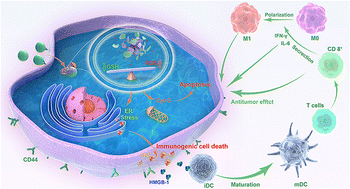Glutathione-sensitive mesoporous nanoparticles loaded with cinnamaldehyde for chemodynamic and immunological therapy of cancer†
Abstract
Chemodynamic therapy as a novel type of chemotherapy can damage the DNA structures and induce cell apoptosis and immunogenic cell death (ICD) through generating reactive oxygen species (ROS) to aggravate oxidative stress. Nonetheless, as an intrinsic antioxidative response of tumor cells, the expression of glutathione (GSH) can be upregulated to maintain the cellular redox balance and protect the tumor cells from ROS-mediated damage. In this context, it is feasible to simultaneously boost ROS generation and GSH depletion in tumor cells; however, the precise delivery and release of GSH scavengers at specific subcellular sites is of great importance. Herein, we propose a GSH-responsive mesoporous organosilica nanoparticle (MON)-based nanomedicine MON-CA-TPP@HA through sequentially covalently attaching triphenylphosphine (TPP) and electrostatically coating hyaluronic acid (HA) onto the surface of cinnamaldehyde (CA)-loaded MONs, known as MON-CA-TPP@HA, which has been demonstrated to be an extremely effective therapeutic strategy for cancer treatment through inducing ICD and apoptosis of breast cancer cells. Systematic in vitro experimental results clearly revealed that the nanomedicine can actively target the tumor cells with the help of HA, subsequently enter the tumor cells, and precisely bind with the mitochondria through TPP residues. Upon cleavaging the disulfide bond in the MONs triggered by over-expressed GSH within tumors, the CA molecules can be released inducing the excessive ROS in situ surrounding the mitochondria to activate oxidative stress to induce apoptosis and ICD of breast cancer cells. The results of the in vivo experiments confirm that the MON-CA-TPP@HA nanomedicine can effectively promote dendritic cell (DC) maturation and CD 8+ T cell activation and regulate the ratio of M1/M2 macrophages, which improve tumor immunosuppressive microenvironment. It is thus believed that the current nanomedicine has paved a new way for future cancer therapy.



 Please wait while we load your content...
Please wait while we load your content...